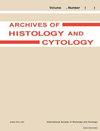正常和链脲佐菌素诱导应激条件下大鼠胰岛细胞中二酰基甘油激酶ζ的定位
Q4 Medicine
引用次数: 3
摘要
总结。胰腺包括外分泌部分和内分泌部分,后者是葡萄糖反应组织,分泌激素以响应血清葡萄糖水平。在这个腺体的调节机制中涉及的一个途径是磷酸肌苷(PI)循环,它产生第二信使。二酰基甘油(DG)是PI信号级联中的主要第二信使,由二酰基甘油激酶(DGK)家族催化。我们之前描述了DGKs在病理生理条件下在不同器官中的特征性表达和定位模式。然而,人们对胰腺中这种酶家族的特征和形态方面知之甚少。本研究旨在研究胰腺,特别是DGK家族的表达和定位。RT-PCR分析显示DGKζ是胰腺中主要的同工酶。此外,我们发现DGKζ在胰岛细胞中表达,而在外分泌细胞中不表达。它主要定位于α-、β-和δ-细胞的细胞核。我们进一步发现DGKζ在β-细胞中响应β-细胞选择性毒素链脲佐菌素(STZ)从细胞核转移到细胞质,并随着时间的推移而消失。这些发现将证实并扩展我们对DGKζ在胰岛细胞中的功能作用的理解。本文章由计算机程序翻译,如有差异,请以英文原文为准。
Localization of diacylglycerol kinase ζ in rat pancreatic islet cells under normal and streptozotocin-induced stress conditions
Summary. The pancreas comprises exocrine and endocrine portions, the latter of which is a glucose-responsive tissue that secretes hormones in response to serum glucose levels. One pathway implicated in the regulatory mechanism of this gland is the phosphoinositide (PI) cycle, which generates second messengers. Diacylglycerol (DG), the major second messenger in the PI signaling cascade, is catalyzed by the diacylglycerol kinase (DGK) family. We previously described characteristic expression and localization patterns of DGKs in various organs under pathophysiological conditions. Nevertheless, little is known about the characteristics and morphological aspects of this enzyme family in the pancreas. This study was conducted to investigate the pancreas, specifically the expression and localization of the DGK family. RT-PCR analysis reveals that DGKζ is the major isozyme in the pancreas. Additionally, we show that DGKζ is expressed in pancreatic islet cells, but not in the exocrine cells. It localizes predominantly to the nuclei of α-, β-, and δ-cells. We found further that DGKζ translocates from the nucleus to the cytoplasm in β-cells in response to a β-cell-selective toxin streptozotocin (STZ) and that it disappears over time. These findings will substantiate and extend our understanding of the functional roles of DGKζ in pancreatic islet cells.
求助全文
通过发布文献求助,成功后即可免费获取论文全文。
去求助
来源期刊

Archives of histology and cytology
生物-细胞生物学
自引率
0.00%
发文量
0
期刊介绍:
The Archives of Histology and Cytology provides prompt publication in English of original works on the histology and histochemistry of man and animals. The articles published are in principle restricted to studies on vertebrates, but investigations using invertebrates may be accepted when the intention and results present issues of common interest to vertebrate researchers. Pathological studies may also be accepted, if the observations and interpretations are deemed to contribute toward increasing knowledge of the normal features of the cells or tissues concerned. This journal will also publish reviews offering evaluations and critical interpretations of recent studies and theories.
 求助内容:
求助内容: 应助结果提醒方式:
应助结果提醒方式:


